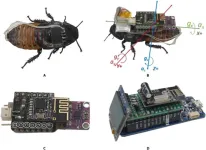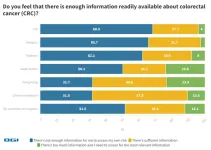(Press-News.org) Have you ever wondered why some insects like cockroaches prefer to stay or decrease movement in darkness? Some may tell you it’s called photophobia, a habit deeply coded in their genes. A further question would be whether we can correct this habit of cockroaches, that is, moving in the darkness just as they move in bright backgrounds. Scientists from Osaka University may have answered this question with a positive answer. They solved this question by converting a cockroach into a cyborg. They published this research in the journal Cyborg and Bionic Systems.
With millions of years of evolution, natural animals are endowed with outstanding capabilities to survive and thrive in hostile environments. In recent years, these animals inspire roboticists to develop automatic machines to recapitulate part of these extinguished capabilities, that is, biologically inspired biomimetic robots. An alternative to this path is to directly build controllable machines on these natural animals by implanting stimulation electrodes into their brains or peripheral nervous system to control their movement and even see what they see, so-called cyborgs. Among these studies, cyborg insects are attracting ever-increasing attention for their availability, simpler neuro-muscular pathways, and easier operation to intrusively stimulate their peripheral nervous system or muscles.
Cockroaches have marvelous locomotion ability, which significantly outperforms any biomimetic robots of similar size. Therefore, cyborg cockroaches equipped with such agile locomotion are suitable for search and rescue missions in unknown and unstructured environments that traditional robots can hardly access.
“Cockroaches prefer to stay in the darkened, narrow areas over the bright, spacious areas. Moreover, they tend to be active in the hotter environment.” explained study author Keisuke Morishima, a roboticist from Department of Mechanical Engineering, Osaka University, “These natural behaviors will hinder the cockroaches to be utilized in unknown and under-rubble environments for search and rescue applications. It will be difficult to apply a mini live stream camera attached to them in a dark or without light areas for real-time monitoring purposes.”
“This study aims to optimize cyborg cockroach movement performance.” said Morishima. To this end, they proposed a machine learning-based approach that automatically detects the motion state of this cyborg cockroach via IMU measurements. If the cockroach stops or freezes in darkness or cooler environment, electrical stimulation would be applied to their brain to make it move.
“With this online detector, the stimulation is minimized to prevent the cockroaches from fatigue due to too many stimulations,” said Mochammad Ariyanto, Morishima’s colleague from Department of Mechanical Engineering, Osaka University.
This idea of restraining electrical stimulation to necessary circumstances, which is determined by AI algorithms via onboard measurements, is intuitively promising. “We don’t have to control the cyborg like controlling a robot. They can have some extent of autonomy, which is the basis of their agile locomotion. For example, in a rescue scenario, we only need to stimulate the cockroach to turn its direction when it’s walking the wrong way or move when it stops unexpectedly.” said Morishima.
“Equipped with such a system, the cyborg successfully increased its average search rate and traveled distance up to 68% and 70%, respectively, while the stop time was reduced by 78%.” said study authors. “We have proven that it’s feasible to apply electrical stimulation on the cockroach’s cerci, it can overcome its innate habit, for example, increase movement in dark and cold environments where it normally decreases its locomotion.”
“In this study, cerci were stimulated to trigger the free-walking motion of the Madagascar hissing cockroach (MHC).” Said the study authors. That is, the applied stimulation drives the cockroach to move randomly.
Looking to the future, the researchers intend to explore more accurate stimulation-movement responses, possibly to control the cyborg cockroaches’ moving direction, paving the way for real-world searching and rescue scenarios.
The research team includes Mochammad Ariyanto from Department of Mechanical Engineering, Graduate School of Engineering, Osaka University, Suita 565-0871, Japan, and Department of Mechanical Engineering, Faculty of Engineering, Diponegoro University, Semarang, 50275, Indonesia, Chowdhury Mohammad Masum Refat, Kazuyoshi Hirao, and Keisuke Morishima from Department of Mechanical Engineering, Graduate School of Engineering, Osaka University, Suita 565-0871, Japan.
The research is funded by the Japan Society for the Promotion of Science Grants-in-Aid for Scientific Research (KAKENHI) and the Japan Science and Technology Agency Moonshot Research & Development Program.
The paper, " Movement Optimization for a Cyborg Cockroach in a Bounded Space Incorporating Machine Learning," was published in the journal Cyborg and Bionic Systems on 6 Feb, 2023, at DOI: https://doi.org/10.34133/cbsystems.0012
END
Movement optimization for a cyborg cockroach in a bounded space incorporating machine learning
2023-04-12
ELSE PRESS RELEASES FROM THIS DATE:
SwRI joins new NASA institute to qualify, certify additive manufacturing methods
2023-04-12
SAN ANTONIO — April 12, 2023—Southwest Research Institute will contribute to a new NASA institute to improve understanding and enable rapid certification of metal parts created using advanced additive manufacturing (AM) techniques. The Institute for Model-based Qualification & Certification of Additive Manufacturing (IMQCAM) will work to improve computer models of additively manufactured metal parts and expand their utility in spaceflight applications.
Additive manufacturing uses 3D printing or rapid prototyping to build ...
Memorial Sloan Kettering Cancer Center experts to present noteworthy research at the American Association for Cancer Research (AACR) 2023 Annual Meeting
2023-04-12
Physicians and scientists from Memorial Sloan Kettering Cancer Center (MSK) will join oncology experts and members of the global cancer research community to present the latest advances in cancer during the American Association for Cancer Research (AACR) Annual Meeting on April 14-19 in Orlando, Florida.
MSK experts will present significant research and will be available to comment on topics including cancer disparities, analytical tools for precision medicine, genomic biomarkers, tumor biology, immunology and more.
Deb Schrag, MD, MPH, will offer insights ...
Noted MS neurologist Dr. Roland Martin wins 2023 John Dystel Prize for Multiple Sclerosis Research
2023-04-12
Roland Martin, MD, a world-class neurologist and investigator, is the winner of the 2023 John Dystel Prize for MS Research. He is being honored for advancing our understanding of immune mechanisms underlying multiple sclerosis and translating them to develop innovative strategies to treat the disease.
Martin uncovered how key MS susceptibility genes are involved in launching immune attacks on the nervous system and identified specific components of nerve-insulating myelin that are targeted by those attacks. His team has developed an experimental therapy designed to make ...
62 percent of Thais lack sufficient colorectal cancer awareness | BGI Insight
2023-04-12
Colorectal cancer (CRC) is the fourth most common cancer and accounts for 11% of the cancer burden in Thailand in 2020, with over 21,000 new CRC cases annually, and stage III and IV CRC account for up to 70%–80% of overall CRC cases, according to the Society of Colorectal Surgeons of Thailand.
This report indicates Thailand has a high percentage of respondents (62.1%) who feel they lack CRC information to assess their risk, far higher than global average of 51.5%. In addition, 48.2% of Thais say that cost concerns are holding them back from CRC screening, way higher than global average of ...
Millions with opioid addiction don't receive residential treatment
2023-04-12
First study to do apples-to-apples comparison of residential treatment use among Medicaid enrollees across several states
Nine states represent 14.9 million people (20% of all Medicaid enrollees)
CHICAGO --- Approximately 7 million adults in the U.S. are living with opioid use disorder (OUD). Yet a new Northwestern Medicine study that measured residential treatment use among Medicaid enrollees across nine states found only 7% of enrollees with OUD received residential treatment, an integral part of the recovery process ...
Looking to boost revenue as an online retailer? Charge an upfront membership fee in exchange for unlimited free shipping
2023-04-12
Researchers from NC State University and Texas A&M University published a new Journal of Marketing article that examines membership fee shipping programs and the effect on consumers’ purchase behaviors and company net revenue.
The study, forthcoming in the Journal of Marketing, is titled “The Effectiveness of Membership-Based Free Shipping: An Empirical Investigation of Consumers’ Purchase Behaviors and Revenue Contribution” and is authored by Fangfei Guo and Yan Liu.
What is the top reason 50% of customers abandon items in online shopping carts? Why do e-commerce brands incur an annual revenue loss of about ...
Toward a safer ‘artificial muscle’ material
2023-04-12
Whether wriggling your toes or lifting groceries, muscles in your body smoothly expand and contract. Some polymers can do the same thing — acting like artificial muscles — but only when stimulated by dangerously high voltages. Now, researchers in ACS Applied Materials & Interfaces report a series of thin, elastic films that respond to substantially lower electrical charges. The materials represent a step toward artificial muscles that could someday operate safely in medical devices.
Artificial muscles could become key components of movable soft robotic implants and functional artificial organs. Electroactive elastomers, such as bottlebrush polymers, are attractive ...
Testing vaccine candidates quickly with lab-grown mini-organs
2023-04-12
Developing and testing new treatments or vaccines for humans almost always requires animal trials, but these experiments can sometimes take years to complete and can raise ethical concerns about the animals’ treatment. Now, researchers reporting in ACS Central Science have developed a new testing platform that encapsulates B cells — some of the most important components of the immune system — into miniature “organoids” to make vaccine screening quicker and greatly reduce the number of animals needed.
Vaccines ...
Your fork could someday be made of sugar, wood powders and degrade on-demand (video)
2023-04-12
Single-use hard plastics are all around us: utensils, party decorations and food containers, to name a few examples. These items pile up in landfills, and many biodegradable versions stick around for months, requiring industrial composting systems to fully degrade. Now, researchers reporting in ACS Sustainable Chemistry & Engineering have created a sturdy, lightweight material that disintegrates on-demand — and they made it from sugar and wood-derived powders. Watch a video about the material here.
Sturdy, degradable materials made from plants and other non-petroleum sources have come ...
Sugar molecule in blood can predict Alzheimer’s disease
2023-04-12
Early diagnosis and treatment of Alzheimer’s disease requires reliable and cost-effective screening methods. Researchers at Karolinska Institutet in Sweden have now discovered that a type of sugar molecule in blood is associated with the level of tau, a protein that plays a critical role in the development of severe dementia. The study, which is published in Alzheimer's & Dementia, can pave the way for a simple screening procedure able to predict onset ten years in advance.
“The role of glycans, ...





